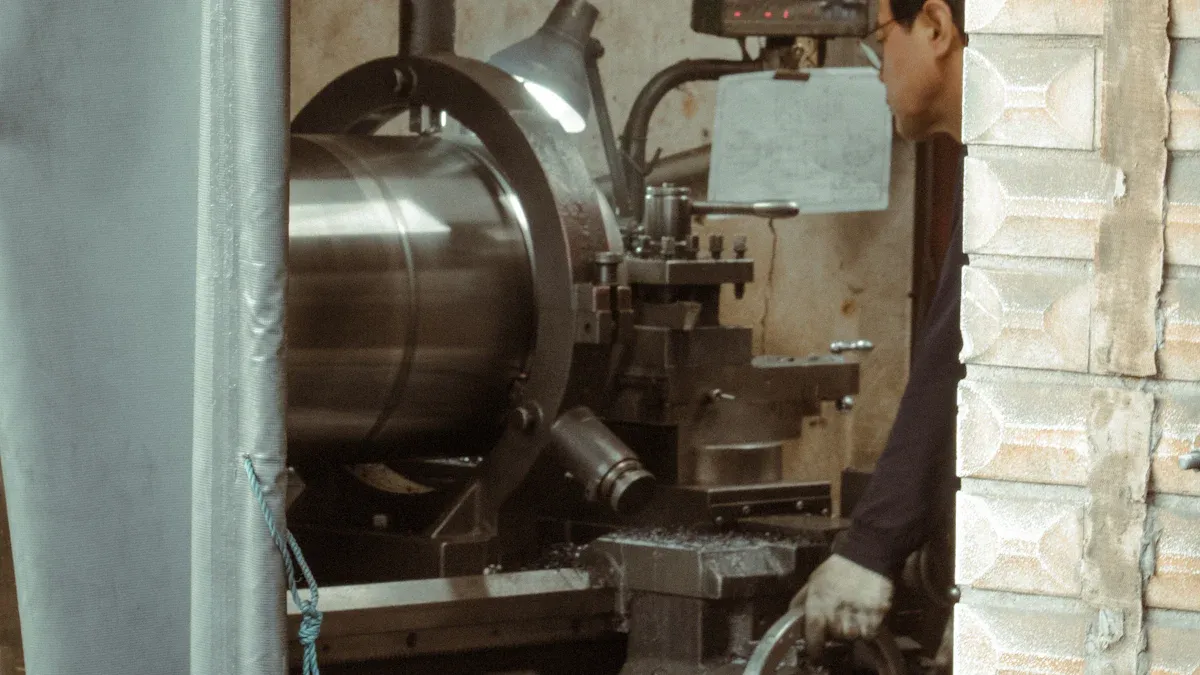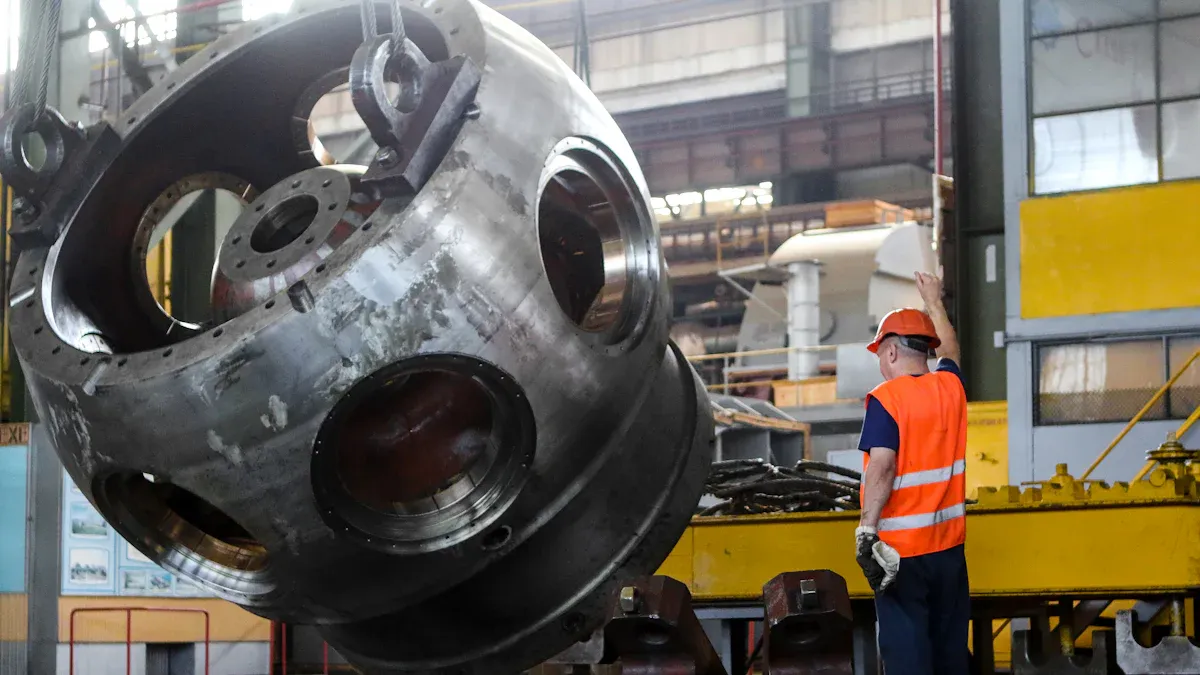
Silicon carbide (SiC) ceramic coatings excel in environments with extreme heat and stress. These sic ceramic coatings offer remarkable durability and thermal stability, making them essential for industries requiring high-performance materials. SiC coatings resist wear, withstand thermal shock, and maintain strength under intense conditions. But what is SiC coating? It is a solution for advanced engineering challenges.
Key Takeaways
- SiC ceramic coatings work well under high heat and pressure. They are important for industries like aerospace and car-making.
- These coatings move heat quickly, stopping things from overheating. This also saves energy in factories.
- SiC coatings are tough against damage and rust. They help machines last longer and need fewer repairs, saving money.
Key Thermal Properties of SiC Ceramic Coatings

High Thermal Conductivity
Silicon carbide (SiC) ceramic coatings exhibit exceptional thermal conductivity. This property allows heat to transfer quickly through the material, making it ideal for applications where efficient heat dissipation is critical. For example, in high-performance engines, these coatings help prevent overheating by evenly distributing heat across surfaces.
The high thermal conductivity of SiC ceramic coatings also enhances energy efficiency in industrial processes. By reducing heat loss, these coatings contribute to maintaining stable operating temperatures. This feature is particularly valuable in industries like aerospace and power generation, where temperature control is essential for safety and performance.
Did you know? SiC ceramic coatings can conduct heat up to three times more efficiently than traditional ceramic materials.
Thermal Shock Resistance
Thermal shock resistance is another standout feature of SiC ceramic coatings. These coatings can endure rapid temperature changes without cracking or losing their structural integrity. This makes them suitable for environments where materials are exposed to sudden heating and cooling cycles.
For instance, in aerospace applications, components coated with SiC must withstand extreme temperature fluctuations during takeoff and reentry. The ability to resist thermal shock ensures that these components remain reliable under such demanding conditions.
Thermal shock resistance also extends the lifespan of equipment. By preventing damage caused by temperature variations, SiC ceramic coatings reduce the need for frequent repairs or replacements.
Low Thermal Expansion
SiC ceramic coatings have a low thermal expansion coefficient, meaning they expand very little when exposed to heat. This property minimizes the risk of deformation or cracking, even under high temperatures. As a result, these coatings maintain their shape and functionality over time.
Low thermal expansion is particularly beneficial in precision applications. For example, in semiconductor manufacturing, SiC coatings ensure that equipment remains stable and accurate during high-temperature processes. This stability is crucial for producing high-quality electronic components.
Additionally, the low thermal expansion of SiC ceramic coatings enhances their compatibility with other materials. By reducing stress at the interface, these coatings improve the overall durability of composite structures.
Mechanical Strength of SiC Ceramic Coatings

Hardness and Wear Resistance
SiC ceramic coatings are renowned for their exceptional hardness. This property makes them highly resistant to wear and abrasion, even in the most demanding environments. The hardness of these coatings stems from the strong covalent bonds within the silicon carbide structure. These bonds create a dense and durable surface that can withstand repeated mechanical stress.
Industries that rely on heavy machinery often use SiC ceramic coatings to protect components from wear. For example, cutting tools coated with SiC maintain their sharpness longer, reducing downtime and improving efficiency. Similarly, pump components in chemical processing plants benefit from the wear resistance of these coatings, ensuring consistent performance over time.
Tip: Regular maintenance of SiC-coated equipment can further extend its lifespan and optimize performance.
High-Temperature Strength
SiC ceramic coatings retain their mechanical strength even at elevated temperatures. Unlike many materials that weaken under heat, these coatings maintain their structural integrity, making them ideal for high-temperature applications. This strength results from the thermal stability of silicon carbide, which resists softening or deformation under extreme conditions.
In the aerospace industry, SiC ceramic coatings protect engine components exposed to intense heat during operation. These coatings ensure that parts remain reliable and safe, even in the harshest environments. Similarly, in power generation, turbines coated with SiC operate efficiently under high thermal loads, contributing to energy production without compromising durability.
The ability to perform under high temperatures also reduces the risk of failure in critical systems. This reliability makes SiC ceramic coatings a preferred choice for industries where safety and performance are paramount.
Corrosion Resistance
SiC ceramic coatings offer excellent resistance to chemical corrosion. Their non-reactive nature protects surfaces from damage caused by acids, alkalis, and other corrosive substances. This resistance is particularly valuable in industries where equipment comes into contact with harsh chemicals.
For instance, in the oil and gas sector, pipelines and valves coated with SiC withstand exposure to corrosive fluids, ensuring uninterrupted operation. Similarly, in marine environments, these coatings protect machinery from saltwater corrosion, extending the lifespan of equipment.
The corrosion resistance of SiC ceramic coatings also reduces maintenance costs. By preventing chemical damage, these coatings minimize the need for repairs or replacements, making them a cost-effective solution for long-term use.
Did you know? SiC ceramic coatings can resist corrosion even in highly acidic or alkaline environments, making them versatile for various applications.
How SiC Ceramic Coatings Are Engineered
Material Composition and Structure
The composition of silicon carbide ceramic coatings plays a critical role in their performance. These coatings primarily consist of silicon and carbon atoms arranged in a crystalline structure. This unique arrangement creates strong covalent bonds, which contribute to the material’s hardness and thermal stability.
Engineers often enhance the composition by adding small amounts of other elements. These additives improve specific properties, such as oxidation resistance or thermal conductivity. For example, incorporating aluminum or yttrium can increase the coating’s ability to withstand high temperatures.
The structure of the coating also matters. Dense, uniform layers ensure better protection against wear and corrosion. A well-engineered structure minimizes defects, which could weaken the coating over time.
Manufacturing Techniques
Several methods are used to produce SiC ceramic coatings. Chemical vapor deposition (CVD) is one of the most common techniques. This process involves reacting silicon and carbon-containing gases at high temperatures to form a thin, uniform coating.
Another popular method is thermal spraying. In this technique, powdered silicon carbide is heated and sprayed onto a surface, creating a durable layer. Plasma spraying, a variation of this method, uses high-energy plasma to melt the powder before application.
Each technique has its advantages. CVD produces coatings with excellent adhesion and uniformity, while thermal spraying is faster and more cost-effective for large-scale applications.
Role of Microstructure in Enhancing Properties
The microstructure of a sic ceramic coating significantly influences its performance. A fine-grained microstructure improves hardness and wear resistance. Smaller grains create a denser surface, which reduces the likelihood of cracks forming under stress.
Porosity is another critical factor. Low porosity enhances the coating’s resistance to corrosion and thermal shock. Engineers carefully control the manufacturing process to minimize pores and ensure a compact structure.
The orientation of grains also affects the coating’s properties. For instance, aligned grains can improve thermal conductivity, making the coating more efficient in heat dissipation. By optimizing the microstructure, engineers can tailor the coating to meet specific application requirements.
Applications of SiC Ceramic Coatings
Aerospace Components
SiC ceramic coatings play a vital role in the aerospace industry. These coatings protect engine parts, turbine blades, and heat shields from extreme temperatures and mechanical stress. Their ability to resist thermal shock ensures that components remain reliable during rapid temperature changes, such as those experienced during takeoff and reentry. Additionally, the lightweight nature of these coatings reduces the overall weight of aircraft, improving fuel efficiency.
In space exploration, SiC ceramic coatings safeguard spacecraft from the harsh conditions of outer space. They provide a barrier against radiation and extreme heat, ensuring the longevity of critical systems. This makes them indispensable for satellites, space probes, and other aerospace technologies.
Automotive Parts
The automotive industry benefits greatly from SiC ceramic coatings. These coatings enhance the performance and durability of engine components, exhaust systems, and braking systems. Their high thermal conductivity helps dissipate heat efficiently, preventing overheating in high-performance engines.
SiC ceramic coatings also improve wear resistance in moving parts, such as pistons and valves. This reduces friction and extends the lifespan of these components. In electric vehicles, these coatings contribute to the efficiency of power electronics by maintaining stable temperatures during operation.
Note: SiC ceramic coatings are increasingly used in hybrid and electric vehicles to improve energy efficiency and reduce maintenance costs.
Industrial Machinery and Equipment
SiC ceramic coatings are essential in industrial settings where machinery operates under harsh conditions. These coatings protect equipment from wear, corrosion, and high temperatures, ensuring consistent performance. For example, pumps and valves in chemical processing plants benefit from the corrosion resistance of these coatings, which prevents damage from aggressive chemicals.
In manufacturing, SiC ceramic coatings enhance the durability of cutting tools and molds. This reduces downtime caused by tool wear and increases productivity. Additionally, their low thermal expansion ensures precision in high-temperature processes, such as metal casting and semiconductor fabrication.
The versatility of SiC ceramic coatings makes them a preferred choice for industries requiring reliable and long-lasting solutions.
Advantages of SiC Ceramic Coatings Over Other Materials
Comparison with Other Ceramic Coatings
SiC ceramic coatings outperform many other ceramic coatings in terms of thermal and mechanical properties. Unlike traditional ceramics, they exhibit superior thermal conductivity, which allows for efficient heat dissipation. This makes them ideal for high-temperature applications. Additionally, their low thermal expansion reduces the risk of cracking, a common issue with other ceramic materials.
In terms of mechanical strength, SiC ceramic coatings offer higher hardness and wear resistance. This durability ensures longer service life compared to coatings like alumina or zirconia. Furthermore, their exceptional corrosion resistance makes them suitable for environments where other ceramics may degrade. These advantages highlight why industries often choose SiC coatings over other ceramic options.
Benefits Over Metal-Based Coatings
Metal-based coatings, while strong, often fail under extreme conditions. SiC ceramic coatings provide a significant advantage by maintaining their properties at high temperatures. Metals tend to soften or deform when exposed to heat, but SiC coatings retain their structural integrity.
Corrosion resistance is another area where SiC coatings excel. Metals are prone to rust and chemical reactions, especially in harsh environments. SiC coatings, on the other hand, resist chemical attacks, ensuring better protection for equipment. Their lightweight nature also reduces the overall weight of components, which is particularly beneficial in industries like aerospace and automotive.
Cost-Effectiveness and Durability
The initial cost of applying SiC ceramic coatings may seem high, but their long-term benefits outweigh the expense. Their durability reduces the need for frequent repairs or replacements, leading to lower maintenance costs. This makes them a cost-effective solution for industries that prioritize reliability and performance.
SiC ceramic coatings also enhance energy efficiency. Their ability to withstand high temperatures and resist wear ensures consistent performance over time. This reliability translates to fewer operational disruptions, saving both time and money. For industries seeking a balance between performance and cost, SiC ceramic coatings offer an unmatched combination of durability and efficiency.
SiC ceramic coating stands out for its exceptional thermal and mechanical properties. Its ability to resist heat, wear, and corrosion makes it indispensable in industries like aerospace, automotive, and manufacturing. These coatings enhance performance and durability in demanding environments. Readers curious about their applications or benefits are encouraged to explore further or ask questions.
FAQ
What industries benefit the most from SiC ceramic coatings?
Industries like aerospace, automotive, and manufacturing benefit significantly. These coatings enhance durability, thermal stability, and corrosion resistance, making them ideal for high-performance applications.
How do SiC ceramic coatings improve energy efficiency?
SiC coatings reduce heat loss and wear. Their high thermal conductivity and durability ensure consistent performance, leading to better energy efficiency in industrial processes.
Are SiC ceramic coatings environmentally friendly?
Yes, they are eco-friendly. Their durability reduces waste from frequent replacements, and their energy efficiency contributes to lower energy consumption in various applications.
Tip: For more details on SiC coatings, consult industry-specific case studies or reach out to experts in material science.


